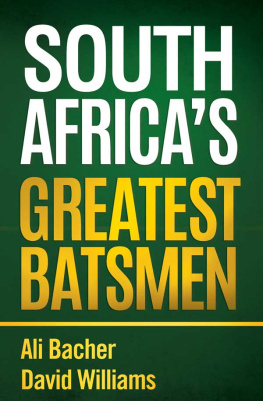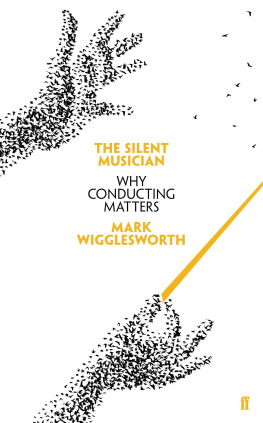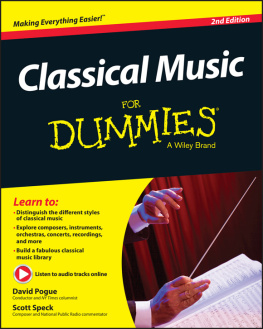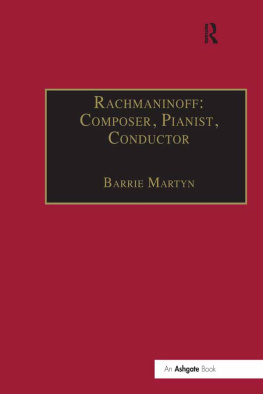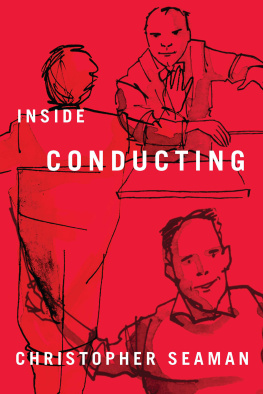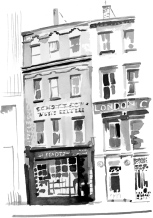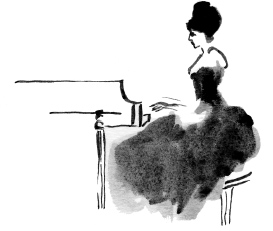David Tidboald
P EOPLE I M ADE M USIC W ITH
candid memoirs
For Tjaart
Published by Umuzi
an imprint of Random House Struik (Pty) Ltd
Company Reg No 1966/003153/07
80 McKenzie Street, Cape Town 8001, South Africa
PO Box 1144, Cape Town 8000, South Africa
www.randomstruik.co.za
Copyright David Tidboald 2008
David Tidboald hereby asserts his right to be
identified as the author of this work.
All rights reserved. No part of this book may be reproduced or transmitted in any form or by any means, mechanical or electronic, including photocopying and recording, or be stored in any information storage or retrieval system, without written permission from the publisher.
ISBN 978-1-4152-0055-1 (Print)
ISBN 978-1-4152-0418-4 (e PUB )
ISBN 978-1-4152-0419-1 ( PDF )
Cover and design of half-titles by Sally Swart
Cover photograph of David Tidboald conducting by Eddie Muir
Pen and wash drawings by Hannah Morris
Design and layout by William Dicey
Set in FFScala
C ONTENTS
P ART O NE : B EFORE 1960
P ART T WO : 1960 O NWARDS
I NTRODUCTION
When one has been privileged to have had a career in one of the arts (in my case as a conductor), which involved working with, and in many cases getting to know, some of the leading artists of the last half century, it does seem something of a waste to make ones departure from this planet without recording impressions of these remarkable people. Though numerous other names appear from time to time in what follows, I have confined myself in general to those I have known personally, some more intimately than others.
They comprise conductors, pianists, composers, dancers and singers, a famous actress and a great writer, the order of their appearance being dictated generally by when I first made their acquaintance, either by way of their work or in person. Sometimes one memory triggers another, so that the narrative moves backwards and forwards, even on occasions sideways.
The first part relates to the years before I took up the first of three permanent posts in South Africa, the second to the years thereafter. The first two pianists appear in the van of the parade because of their association with my earliest awareness of music and music-making.
Two pianists
M OURA L YMPANY 19162005
Moura Lympany was the first pianist I ever heard in a concerto well, hardly a concerto, it was Vincent dIndys Symphony on a Mountaineers Song. I was ten or eleven. The orchestra was Plymouths amateur group and, like many such, they had no fears as to the music they tackled: in the same programme as the dIndy was Strausss Death and Transfiguration. Their conductor was a medical man by the name of Weekes. He used to come to my preparatory school in Plymouth before the concerts to talk about the music we were soon to hear, illustrating the items on the piano that usually accompanied hymns at our morning assemblies but on these occasions had the hell knocked out of it as the good Doctor sought to indicate the thrills we had in store. A party of us Mount House students were taken, together with a bevy from a girls school nearby, in a special bus, and one of those obscure but indelible memories one has of ones early days is of the bus starting up before bearing us off to the concert, the degree of excitement at the prospect no doubt abetting the vividness of the memory. I dont recall the date of this particular concert but it must have been before the Second World War, for it took place at the Guildhall, an early casualty of the blitz. We sat behind the orchestra and, of course, I found the impact of that wonderful piece of human machinery overwhelming. Moura was by way of being a local girl, having been born in Saltash, just across the river Tamar from Plymouth. During the war one often heard her on the wireless, especially in connection with the Khachaturian Piano Concerto, of which she was one of the earliest interpreters. Her recording of the piece helped to spread her name around the world.
I first came to work with and get to know Moura in 1962 when we did a concert together at the Royal Festival Hall in London (Beethoven Piano Concerto No. 3). This was only the first of many collaborations, as she often visited South Africa during the years I conducted first in Cape Town and then in Durban. She was one of the early soloists with the Natal Philharmonic Orchestra in Durban in the eighties in the newly transformed Playhouse, one of the mod cons in which there was a lift in the orchestra pit that could rise to become an extension of the stage and which accommodated the piano for the night. On one occasion when Moura was the soloist (Saint-Sans Piano Concerto No. 2), the lift stuck and she was obliged to play some six feet below the level of the orchestra. Good sport that she was, she coped with the situation, but it must have rattled her somewhat, for in the last movement where Saint-Sans indulges in a seemingly endless succession of trills up and down the keyboard, Moura got hopelessly lost; lost but undaunted, round and round she went, thrashing her way through a jungle of keys until (to mix ones metaphors) she found dry land. Backstage afterwards we fell into each others arms in helpless laughter.
During the last years of her working life, Moura was engaged to entertain guests on the Queen Elizabeth II on worldwide cruises, a job which, given her sociable nature, suited her well. These cruises often included South African ports, and on one of these occasions, in Durban, she called on us. Sitting by the pool, she unburdened herself of a gripe or two that had been hanging round the back of her mind. Nol Cowards diaries had been published quite a few years before, but a statement to be found there still niggled her. He wrote of a visit that Moura and her then husband, an American television executive by the name of Bennet Korn, had paid to his Jamaican home. She had played for him and hed come to the conclusion that she was an excellent pianist but not a great musician. What did he mean? she demanded, more than once. It also annoyed her that, though shed recorded the complete Rachmaninoff Preludes (twice), most commentators had merely deplored the fact that Rachmaninoff himself had not been invited to do so. It is indeed scandalous, but scarcely her fault. But she was not really the moaning sort. In fact, she remarked once that shed never have need of a psychiatrist so long as a glass or two of Mot & Chandon were still available.
She often spoke of giving up her ruinously expensive Monte Carlo apartment and relocating to South Africa. Unfortunately she never did.
B ENNO M OISEIWITSCH 18901963
As a schoolboy, I had in my collection two concertos recorded by Benno Moiseiwitsch, the Rachmaninoff Second Piano Concerto and Beethovens Emperor, and by a happy coincidence it was these two pieces he played with us in June 1962 on his fourth and last visit to South Africa.
James Agate, the great theatre critic, who was a close friend of Moiseiwitsch, described in his diary entry for 23 November 1937 how he attended the recording sessions of the Rachmaninoff:



